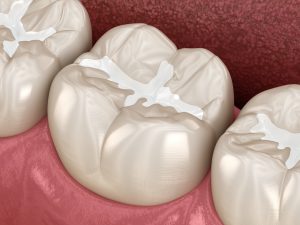Powerful Cavity Prevention That Protects Your Child’s Smile
Dental sealants represent one of the most effective preventive treatments available in modern dentistry, preventing up to 80% of cavities in the back teeth, where children are most vulnerable to decay. At Pristine Dental in Scottsdale, Dr. Stephanie Smith and Dr. Keith Cooper use advanced sealant technology to provide children with long-lasting protection that keeps their developing smiles healthy and strong.
Ready to protect your child’s teeth with proven cavity prevention? Call Pristine Dental at (480) 935-2424 today to schedule a sealant consultation with our Scottsdale dentists. Serving families from Paradise Valley, Fountain Hills, and Phoenix with advanced preventive care that keeps children’s smiles cavity-free.
Family-Focused Care Across All Ages
 Pristine Dental stands out as a true family dental hub in Scottsdale, where general dentistry meets pediatric and adult needs under one roof, eliminating the hassle of multiple appointments. With services ranging from routine cleanings and orthodontics to wisdom tooth extractions and Invisalign, the practice is equipped to handle every family member’s concerns—from teething toddlers to aging parents—using gentle techniques that prioritize comfort and education. Dr. Smith’s community outreach, including volunteering for “Give Kids a Smile,” infuses a nurturing ethos that makes visits enjoyable rather than daunting.
Pristine Dental stands out as a true family dental hub in Scottsdale, where general dentistry meets pediatric and adult needs under one roof, eliminating the hassle of multiple appointments. With services ranging from routine cleanings and orthodontics to wisdom tooth extractions and Invisalign, the practice is equipped to handle every family member’s concerns—from teething toddlers to aging parents—using gentle techniques that prioritize comfort and education. Dr. Smith’s community outreach, including volunteering for “Give Kids a Smile,” infuses a nurturing ethos that makes visits enjoyable rather than daunting.
What makes this unique is the all-in-one approach: in-house oral surgery and sedation options ensure seamless care without referrals, while the spa-like atmosphere with massage chairs and Netflix in treatment rooms keeps everyone relaxed. Families choose Pristine for its dedication to building generational trust, offering everything from sealants for kids to dentures for seniors, all with a focus on preventive strategies that save time and money long-term.
What Are Dental Sealants and How Do They Work?
 Dental sealants are thin, protective plastic coatings applied to the chewing surfaces of back teeth, creating a smooth barrier that prevents bacteria and food particles from accumulating in the deep grooves and pits where cavities most commonly develop. These microscopic spaces are often too narrow for toothbrush bristles to reach effectively, making them vulnerable areas even with good oral hygiene.
Dental sealants are thin, protective plastic coatings applied to the chewing surfaces of back teeth, creating a smooth barrier that prevents bacteria and food particles from accumulating in the deep grooves and pits where cavities most commonly develop. These microscopic spaces are often too narrow for toothbrush bristles to reach effectively, making them vulnerable areas even with good oral hygiene.
The sealant material bonds directly to the tooth enamel, forming a protective shield that can last for many years with proper care. Unlike fillings that treat damage after it occurs, sealants prevent problems from developing in the first place, preserving natural tooth structure and avoiding the need for more extensive treatments later.
The Dental Sealant Application Process
Dr. Smith’s systematic approach ensures optimal sealant placement and longevity:
- Tooth Assessment: Thorough evaluation of permanent molars to determine which teeth would benefit most from sealant protection based on groove depth and cavity risk.
- Surface Preparation: Gentle cleaning of tooth surfaces to remove any plaque or debris that could interfere with proper sealant bonding.
- Isolation and Drying: Careful isolation of treatment teeth and thorough drying to create optimal conditions for sealant adhesion.
- Conditioning Application: Brief application of conditioning solution that prepares the tooth enamel for strong sealant bonding.
- Sealant Placement: Precise application of sealant material into all grooves and pits using specialized applicators that ensure complete coverage.
- Light Curing: Activation of sealant material using specialized lights that harden the protective coating in seconds.
- Bite Adjustment: Careful evaluation and adjustment of sealant thickness to ensure comfortable biting and chewing function.
- Final Inspection: Thorough examination of completed sealants to verify complete coverage and proper placement for optimal protection.
Ideal Candidates for Dental Sealants
Sealants provide maximum benefit when placed on appropriate teeth at the optimal time:
Children Ages 6-14: The ideal age range for sealant placement coincides with permanent molar eruption, providing protection during the most cavity-prone years of childhood and adolescence.
- Deep Groove Anatomy: Children whose permanent molars have deep grooves, pits, or fissures that are difficult to clean effectively with regular brushing benefit most from sealant protection.
- High Cavity Risk: Patients with a history of cavities, poor oral hygiene, frequent snacking, or medical conditions that increase decay risk receive significant benefits from additional protective measures.
- Newly Erupted Molars: Teeth that have recently emerged through the gums are ideal candidates because the enamel is still maturing and most susceptible to cavity formation.
- Orthodontic Patients: Children undergoing orthodontic treatment often struggle with effective cleaning around brackets and wires, making sealant protection particularly valuable during treatment periods.
- Special Needs Patients: Children with physical or cognitive challenges that make thorough oral hygiene difficult benefit significantly from additional preventive protection that sealants provide.
Benefits of Dental Sealants
Professional sealant application provides numerous advantages for long-term oral health:
- Exceptional Cavity Prevention: Research demonstrates that sealants prevent 80% of cavities in permanent molars during the first two years, with continued significant protection for up to nine years.
- Cost-Effective Prevention: Sealant application costs significantly less than treating cavities with fillings, crowns, or other restorative procedures that become necessary without preventive intervention.
- Painless Application: The sealant placement process requires no anesthesia, drilling, or discomfort, making it an ideal preventive treatment for children who may be anxious about dental procedures.
- Immediate Protection: Sealants provide instant cavity protection that begins working immediately after application, unlike other preventive measures that require ongoing compliance.
- Long-Lasting Results: Properly applied sealants can provide protection for many years, often lasting through the most cavity-prone childhood and teenage years.
- Preserves Natural Teeth: By preventing cavities, sealants help children keep their natural teeth healthy and strong throughout their lives without the need for extensive restorative treatments.
- Improved Oral Hygiene: Sealed surfaces are easier to clean than deep grooves, making daily brushing more effective and helping children maintain better overall oral health.
- Enhanced Confidence: Children with sealed teeth experience fewer cavities, dental pain, and treatment needs, leading to more positive associations with dental care and better oral health habits.
Dental Sealants vs. Other Preventive Treatments
Understanding how sealants compare to other preventive options helps families make informed decisions:
Sealants vs. Fluoride Treatments
While fluoride strengthens tooth enamel and provides general cavity protection, sealants create physical barriers that prevent bacteria from reaching vulnerable tooth surfaces. These treatments complement each other rather than compete, with many children benefiting from both approaches.
Fluoride treatments require ongoing applications and daily compliance with fluoride toothpaste, while sealants provide continuous protection for years after a single application.
Sealants vs. Regular Dental Cleanings
Professional teeth cleanings remove existing plaque and tartar buildup but don’t prevent future accumulation in deep grooves where brushes can’t reach effectively. Sealants fill these vulnerable spaces, making cleaning more effective and reducing cavity risk even between professional appointments.
Both treatments are important components of comprehensive preventive care, with sealants enhancing the effectiveness of regular cleanings and home care routines.
Caring for Sealed Teeth
Proper care helps maximize sealant longevity and effectiveness:
Daily Oral Hygiene
 Children with sealed teeth should continue regular brushing with fluoride toothpaste and daily flossing to maintain overall oral health. Sealants don’t eliminate the need for good oral hygiene, but make cleaning more effective by creating smooth surfaces that resist plaque accumulation.
Children with sealed teeth should continue regular brushing with fluoride toothpaste and daily flossing to maintain overall oral health. Sealants don’t eliminate the need for good oral hygiene, but make cleaning more effective by creating smooth surfaces that resist plaque accumulation.
Regular brushing helps maintain sealant surfaces while protecting unsealed areas that remain vulnerable to decay without consistent care.
Dietary Considerations
While sealants provide excellent protection, avoiding excessive consumption of sticky, sugary foods helps preserve both sealed and unsealed tooth surfaces. Hard foods that could potentially damage sealant materials should be consumed carefully.
Dr. Smith provides specific dietary guidance based on individual sealant materials and each child’s cavity risk factors to maximize protection while maintaining normal eating patterns.
Regular Monitoring
Professional examinations every six months allow Dr. Smith to monitor sealant condition and effectiveness while identifying any areas that might need touch-up or replacement. Early detection of sealant wear helps maintain continuous protection.
Sealant Longevity and Maintenance
Understanding sealant lifespan helps families plan for ongoing preventive care:
Expected Durability
Most sealants last five to 10 years with proper care, though longevity varies based on individual factors such as bite force, dietary habits, and oral hygiene effectiveness. Some sealants may last even longer, while others might need earlier replacement due to wear or damage.
Dr. Smith evaluates sealant condition during regular checkups and recommends replacement when necessary to maintain continuous protection during the most vulnerable years.
Signs That Replacement May Be Needed
Partial sealant loss, chips, or wear patterns that expose underlying grooves indicate the need for evaluation and possible replacement. Regular professional monitoring helps identify these issues before cavity development occurs.
Children and parents should report any changes in sealed tooth surfaces, such as rough areas or visible damage, to maintain optimal preventive protection.